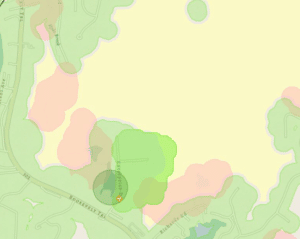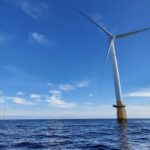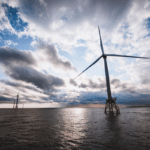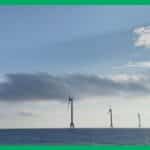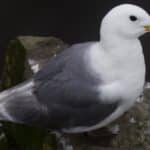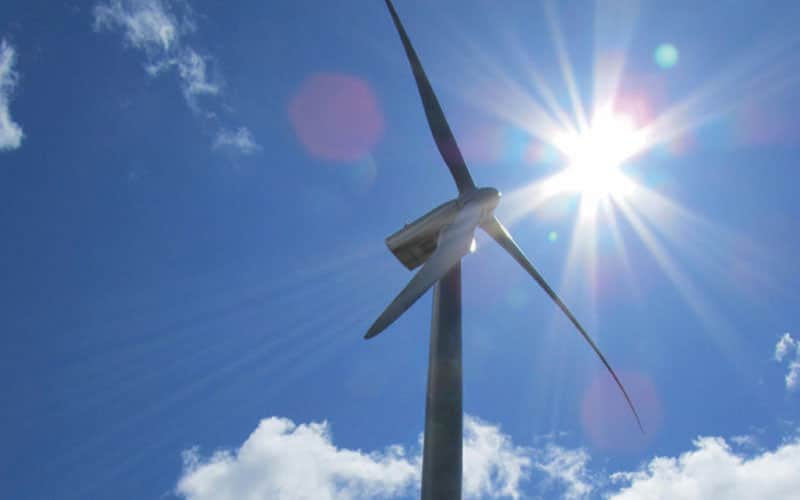
The biggest and most pervasive threat to Maine’s wildlife and habitat is climate change driven by carbon pollution. As the push for renewable energy increases, we strive to understand the impact of wind power development on wildlife and habitat, and support siting and operating of renewable wind energy in places and ways that avoid or minimize those impacts.
Both terrestrial and offshore wind are very likely to play a role in Maine’s energy future, though the impacts of offshore wind on wildlife have not been studied as much as terrestrial wind.
Terrestrial Wind Resources
As a part of our 2019 report, “Renewable Energy and Wildlife in Maine: Avoiding, Minimizing, and Mitigating Impacts to Wildlife and Habitat from Solar, Wind, and Transmission Facilities,” we updated the GIS analysis used in the 2013 report (below) using new wind resource data for 100m and 140m hub heights, and updated wildlife resource data. The results were published as A Statewide Geographic Analysis of the Intersection of High-value Wildlife Resources and Wind Resources (2019): Full Report.
Recent advancements in wind turbine technology have led to the development of wind turbines able to capture wind energy at higher elevations where winds are stronger and more consistent. The 2019 GIS analysis maps the geographic expansion of wind resources made available by these technological advances, as well as the most current information on locations of wildlife resources and natural communities.
This report does not replace Maine Audubon’s 2013 report, but instead supplements it. We encourage you to review the 2013 report first as it includes extensive background information on wind power and wildlife, and an assessment of the potential to meet the state’s goal of 3,000 MW capacity of wind energy by 2030 with minimal impact to Maine’s wildlife resources. Knowing that the goal is obtainable, the 2019 GIS analysis focuses specifically on changes resulting from the new wind and wildlife data and is a part of our larger report on renewable energy and wildlife in Maine.
In 2013, Maine Audubon developed a report, Wind Power and Wildlife in Maine: A Statewide Geographic Analysis of High-Value Wildlife Resources and Wind Power Classes, that identified areas of the state that are most appropriate or least appropriate for commercial wind development based on impacts to wildlife and habitat. The 2013 report also assessed the feasibility of the State of Maine’s goal of generating 3,000 MW (megawatts) of electricity from on-shore and off-shore wind power by 2030. The analysis used in this report was based on wind resources available to wind turbines with 80m hub heights.
Follow these links to view the Executive Summary and Full Report, and to view a summary of our Wind Power Siting Guidelines:
Wind Power and Wildlife in Maine (2013): Summary
This GIS tool provides resources developers and decision-makers need to locate solar and land-based wind projects in areas that avoid or minimize negative impacts to important wildlife habitats. While many of the included data layers are individually available elsewhere, this tool brings these datasets together into one map and allows the visual display of siting principles developed by Maine Audubon’s biologists and ecologists.
Offshore Wind Resources
A comprehensive study of what scientists know – and don’t know – about the potential wildlife impacts from proposed floating offshore wind in the Gulf of Maine, published in Habitat Magazine, 2022.
View the report here.
Maine Audubon hosts virtual, educational presentations focused on issues related to the development of offshore wind in the Gulf of Maine. Watch the recordings of these informational webinars.
May 25, 2023: Climate Change in the Gulf of Maine
A program about the changing conditions in the Gulf of Maine. Delivered by Dr. Katherine Allen of the University of Maine School of Earth and Climate Sciences Cooperating Appointment, Climate Change Institute.
View the recording here (YouTube)
April 19, 2022: Offshore Wind Roadmap Update
Deputy Director Celina Cunningham of the Governor’s Energy Office; Conservation Biologist/GIS Manager Sarah Haggerty of Maine Audubon; and Advocacy Director Eliza Donoghue of Maine Audubon with updates on progress towards offshore wind in the Gulf of Maine.
View the recording here (YouTube)
March 23, 2021: Offshore Wind Energy and Maine: A Primer
Dr. Habib Dagher
View the recording here (YouTube)
March 30, 2021: Offshore Wind and Birds
Wing Goodale, BRI and Dr. Roberto Albertani
View the recording here (YouTube)
April 6, 2021: Offshore Wind and the Environment
Dr. Trevor Peterson and Dr. Sofie Van Parijs, National Oceanic and Atmospheric Administration
View the recording here (YouTube)
April 13, 2021: Offshore Wind Energy in the Gulf of Maine
Director Dan Burgess and Deputy Director Celina Cunningham of the Governor’s Energy Office
View the recording here (YouTube)

